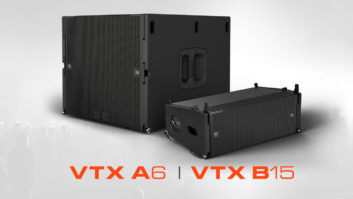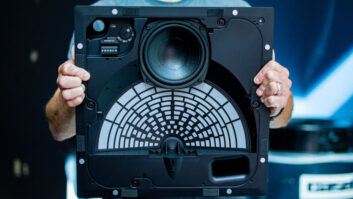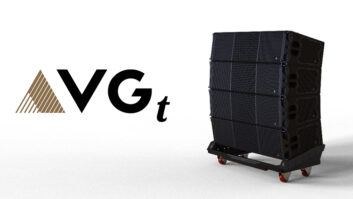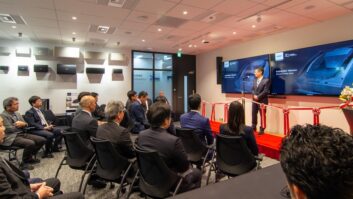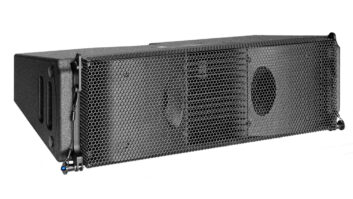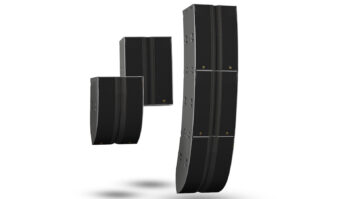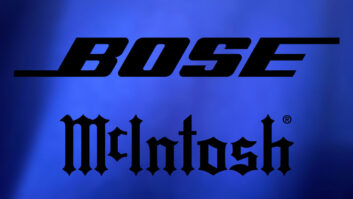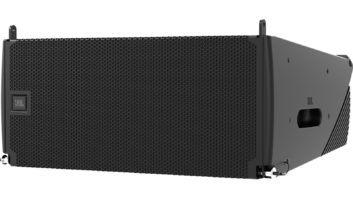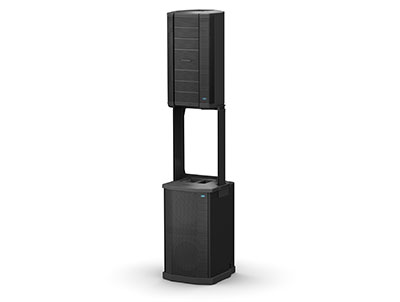
Bose may not be the first brand that comes to mind when you think portable line array, but the company’s track record for innovation is certainly well established. Recently, Bose turned its efforts toward developing small-format line array systems. One of those is the F1 Model 812 Flexible Array, the subject of this review.
Power and Flexibility
The Model 812 is a bi-amplified, powered portable line array with eight midrange/high-frequency drivers and a 12-inch woofer that extends the frequency range down to 52 Hz (-3 dB). What’s really unique about the Model 812 is that the mid/high drivers are mounted on a flexible baffle with a 100-degree waveguide. The two middle drivers are fixed, pointing straight ahead. The top and bottom drivers are grouped in sets of three on panels that normally face straight ahead (same as the middle two) but may be directed up or down, respectively. This allows the vertical coverage angle to be modified to accommodate the venue.
Illustrated very clearly in the manual, each coverage pattern has a distinct application. The straight pattern is for situations where the 812s are at the same height as a standing audience. The J pattern is for venues where the 812s are elevated (e.g., on stage), and the audience is seated, thus directing coverage down toward the seats. The inverted J pattern is intended for “raked” seating where the first rows of seats are at the height of the P.A. and the rear seats are raised. The C pattern is useful in raked auditoriums where the front rows are lower than the 812s, and seats are elevated toward the rear of the room.
Initially, I thought the flexible baffle was a bit of a gimmick but that proved not to be the case—it works quite effectively. Specs for the Model 812 are minimal: nominal dispersion for the C pattern is stated on the Website as 100×40 degrees (HxV_ and amplification is 1,000 watts, Class-D.
Found on the rear panel are two inputs with independent volume control. One is a Combo jack with a mic/line switch. The other uses a ¼-inch TS/TRS jack or sums a pair of stereo RCA jacks to mono. Given the Combo jack’s mic/line switch, you could use the Model 812 for a karaoke gig without a mixer, but that’d be a waste of resources because it’s capable of much more. An XLR line output feeds audio to another 812 or F1 Subwoofer; its EQ switch (labeled Full Range and With Sub) engages a 100Hz HPF for the 812. Another switch determines the operation of the front-panel LED, with positions for Off, Power (the LED is on when the speaker is powered) or Limit (the LED is normally off but turns on when limiting is applied). Multi-color LEDs are provided for input Signal/Clip, system Power/Fault and Limit.
Integrating the Sub
Execution of the 812’s molded enclosure is smart. Handles are built into the top and rear, making it relatively easy to carry. Threaded M8 inserts enable flying, and the bottom panel accepts a standard 35mm pole or the F1 Subwoofer’s included support stand.
A pair of Model 812s can create quite a stir, but the real muscles flex when you combine them with the F1 Subwoofer. Also a powered design, the F1 Sub is a fine little beasty in a reasonably sized box. Two 10-inch woofers generate a maximum SPL of 130 dB peak and LF response down to 40 Hz (-3 dB). The F1 Sub’s enclosure aesthetically matches the 812 and includes a mounting bracket that nests with the cabinet for transport, or snaps into the top to support an 812. Rear panel features of the F1 Sub include a pair of Combo line-level inputs; XLR line outs with Thru/HPF switch, volume control, polarity reverse and the same System LEDs as the 812. All models have IEC power inlets and on/off switches.
Specs Be Damned!
It’s just as well that I wasn’t buried in ‘specs because it would have taken all of the fun out of using this P.A. For many of the tests, an F1 Subwoofer was placed at either side of the stage in a 200-seat auditorium at Mercy College (Dobbs Ferry, N.Y.) and an 812 was set atop each F1 Sub’s stand. The output from a Behringer X32 was connected to the 812’s input, EQ set to With Sub, and the 812’s output was patched to the F1 Sub’s input. Volume controls were set to nominal (though I eventually cranked them up to see how loud they’d play). This system rocked. At the front of the room the system could play way louder than necessary, and at the back of the room, it was still almost loud enough to smack your gut.
Of course, brute force is not enough, and the F1 System is not a brute. I used it for rap, rock, pop and electronica, and it sounded great in all cases: extended at both ends, balanced and smooth, no horn harshness that plagues a lot of P.A. speakers. The F1 System provided excellent transient response on percussion, and tight, powerful, articulate bass. Imaging during the electronic performances was surprisingly good—sitting almost directly in front of the P.A. on house right, I could still hear the array on house left, and coverage across the middle was consistent.
The Model 812’s ability to modify vertical coverage is impressive. During sound check for the initial performances, it became apparent that the front few rows were not hearing the midrange and highs properly. A quick snap of the bottom driver panels fixed the issue, creating a J pattern that clearly focused the bottom part of the array toward the neglected seating area. As an experiment, I placed the P.A. on the floor, in which case the rear rows were not being covered due to the rake. Changing the top array panel fixed that in seconds.
The manual doesn’t say much regarding what happens electronically when adjusting the baffle, mentioning that the EQ curve is changed—but I suspect there may also be some phase adjustment to keep the drivers coherent. Regardless, the concept is effective and avoids the coverage issues that challenge conventional boxes.
It’s a Hit
The Bose F1 System is impressive. It sounds fantastic, breaks down into components that fit into a car, requires no external electronics or fussing with a crossover, and can adapt to venues requiring a variety of vertical coverage patterns. The review system would make a killer band or portable DJ system. It may be a tad pricey for those in the MI market, but anyone with professional requirements absolutely needs to hear the Bose F1 System.
Steve La Cerra is a New York–based live sound and recording engineer.
Product Summary
COMPANY: Bose Corporation
PRODUCT: Model 812 Line Array, F1 Subwoofer
WEBSITE: www.bose.com
PRICE: F1 Model 812 Flexible Array, $1199.95 each; F1 Subwoofer $1199.95 each
PROS: Excellent sound; easy setup with built-in stands; manageable package.
CONS: A bit on the pricey side; no phantom power on the Model 812 mic input.
